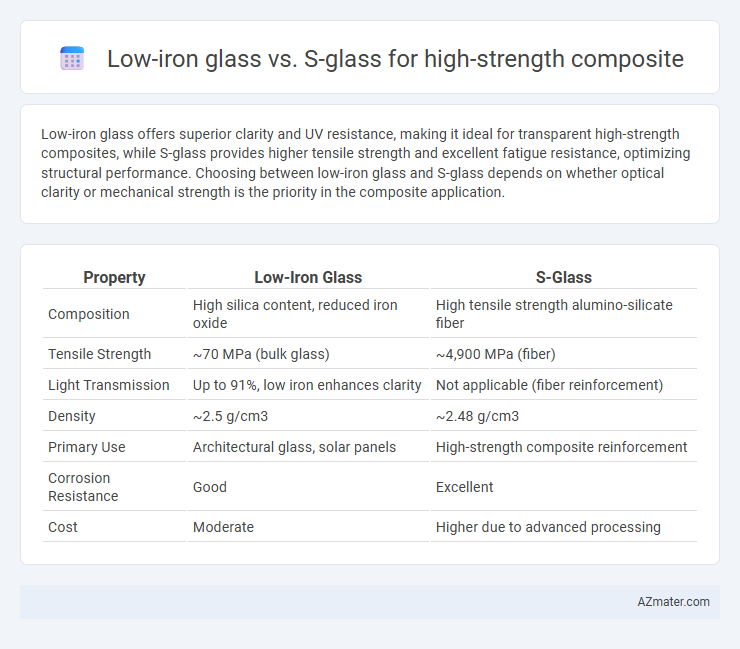Low-iron glass offers superior clarity and UV resistance, making it ideal for transparent high-strength composites, while S-glass provides higher tensile strength and excellent fatigue resistance, optimizing structural performance. Choosing between low-iron glass and S-glass depends on whether optical clarity or mechanical strength is the priority in the composite application.
Table of Comparison
| Property | Low-Iron Glass | S-Glass |
|---|---|---|
| Composition | High silica content, reduced iron oxide | High tensile strength alumino-silicate fiber |
| Tensile Strength | ~70 MPa (bulk glass) | ~4,900 MPa (fiber) |
| Light Transmission | Up to 91%, low iron enhances clarity | Not applicable (fiber reinforcement) |
| Density | ~2.5 g/cm3 | ~2.48 g/cm3 |
| Primary Use | Architectural glass, solar panels | High-strength composite reinforcement |
| Corrosion Resistance | Good | Excellent |
| Cost | Moderate | Higher due to advanced processing |
Introduction to High-Strength Composite Materials
High-strength composite materials combine fibers like low-iron glass or S-glass with polymer matrices to achieve superior mechanical properties. Low-iron glass offers enhanced clarity and corrosion resistance, making it suitable for applications demanding transparency and durability. S-glass provides higher tensile strength and stiffness, ideal for structural components requiring maximum load-bearing capacity and impact resistance.
Overview of Low-Iron Glass
Low-iron glass features reduced iron content, enhancing light transmission and clarity, making it ideal for high-strength composite applications that require maximum optical performance. Its superior transparency compared to standard glass ensures improved aesthetic quality and increased durability in composite materials. Low-iron glass is commonly used in architectural, solar, and specialty composites where strength and visual clarity are critical.
Understanding S-Glass
S-Glass, a high-strength alumino-silicate fiber, offers superior tensile strength and modulus compared to traditional low-iron glass fibers, making it ideal for high-performance composite materials used in aerospace and defense applications. Unlike low-iron glass, which primarily reduces color impurities for enhanced optical clarity, S-Glass provides exceptional mechanical properties such as improved fatigue resistance and impact toughness. This makes S-Glass the preferred reinforcement fiber when composite strength and durability are critical factors in structural performance.
Chemical Composition Comparison
Low-iron glass primarily consists of silica (SiO2), with reduced amounts of iron oxides to enhance transparency and minimize coloration, benefiting optical clarity in composites. In contrast, S-glass is an alumino-silicate glass with high silica (approximately 65-67%) and alumina (around 25%) content, specifically engineered for superior tensile strength and chemical durability. The distinct chemical compositions result in varied mechanical properties, with S-glass offering enhanced high-strength performance in composite applications due to its optimized alumina content.
Mechanical Strength Differences
Low-iron glass typically offers lower tensile strength compared to S-glass, with S-glass exhibiting tensile strengths around 4.8 GPa, significantly higher than the 2-3 GPa range of low-iron glass. This enhanced mechanical strength of S-glass results from its optimized chemical composition, including higher silica and alumina content, improving modulus and impact resistance in high-strength composites. Consequently, S-glass is preferred in aerospace and military applications where superior mechanical performance and durability are critical.
Optical Properties and Clarity
Low-iron glass offers superior optical clarity due to its minimal iron content, reducing the greenish tint common in standard glass and enhancing light transmission in high-strength composite applications. S-glass provides excellent mechanical strength and thermal stability but typically exhibits lower optical clarity because of higher iron oxide levels that can cause color distortion and reduced transparency. Choosing between low-iron glass and S-glass depends on balancing the application's optical requirements with its mechanical performance needs.
Weight and Density Considerations
Low-iron glass exhibits a density of approximately 2.5 g/cm3, which is slightly lower than S-glass, known for a density around 2.48-2.52 g/cm3, contributing to modest differences in composite weight. S-glass fibers provide superior tensile strength reaching up to 4.9 GPa, enabling high-strength composites to maintain reduced weight without compromising durability. Weight-sensitive applications favor S-glass composites due to the optimized balance between fiber density and mechanical performance in aerospace and sporting goods industries.
Cost Analysis: Low-Iron Glass vs. S-Glass
Low-iron glass offers a cost-effective alternative to S-glass in high-strength composites, with significantly lower material and manufacturing expenses due to its simpler production process. S-glass provides superior tensile strength and thermal resistance but commands a premium price, often 2 to 3 times higher than low-iron glass, impacting overall project budgets. Cost analysis must weigh the trade-off between low-iron glass's affordability and S-glass's enhanced mechanical properties to determine the optimal choice for specific composite applications.
Applications in High-Strength Composites
Low-iron glass offers superior clarity and UV resistance, making it ideal for high-strength composites in architectural panels and solar modules where transparency and durability are critical. S-glass provides higher tensile strength and thermal stability, commonly used in aerospace, automotive, and defense applications requiring enhanced mechanical performance and weight savings. Both materials are integral to advancing composite technologies, with low-iron glass optimized for optical applications and S-glass tailored for structural reinforcement.
Choosing the Right Glass for Composite Performance
Low-iron glass offers superior clarity and enhanced UV resistance, making it ideal for composites requiring high optical performance and durability. S-glass provides exceptional tensile strength and improved impact resistance, preferred in high-strength composite applications demanding maximum structural integrity. Selecting between low-iron glass and S-glass depends on balancing optical clarity needs against mechanical performance requirements in advanced composite manufacturing.

Infographic: Low-iron glass vs S-glass for High-strength composite
 azmater.com
azmater.com